A 3-day Private Tour, with some specific targets we wanted to see. It was cloudy and cold on Monday, though the wintry flurries were thankfully brief and light, but with a very blustery and cold NE wind which hampered us at times. Tuesday and Wednesday were much brighter with some nice long spells of winter sunshine, though the wind only eased slowly.
Monday 8th January
Our primary target today was to see if we could locate the Red-breasted Goose. Figuring it didn’t fly out from the saltmarsh to the fields until around 10am yesterday, we decided to head down to Wells first and have a look in the harbour. We could see the trees being lashed around when we arrived in the car park and as we got up past the lifeboat station, we were face on into the biting cold wind. We had a quick scan from the slipway – four distant Red-breasted Mergansers were in the outer channel, and a couple of Bar-tailed Godwits and a Grey Plover were feeding along the near edge in front of us. A Curlew was on the shore the other side, and lots of Dunlin were running around on the wet sand behind.
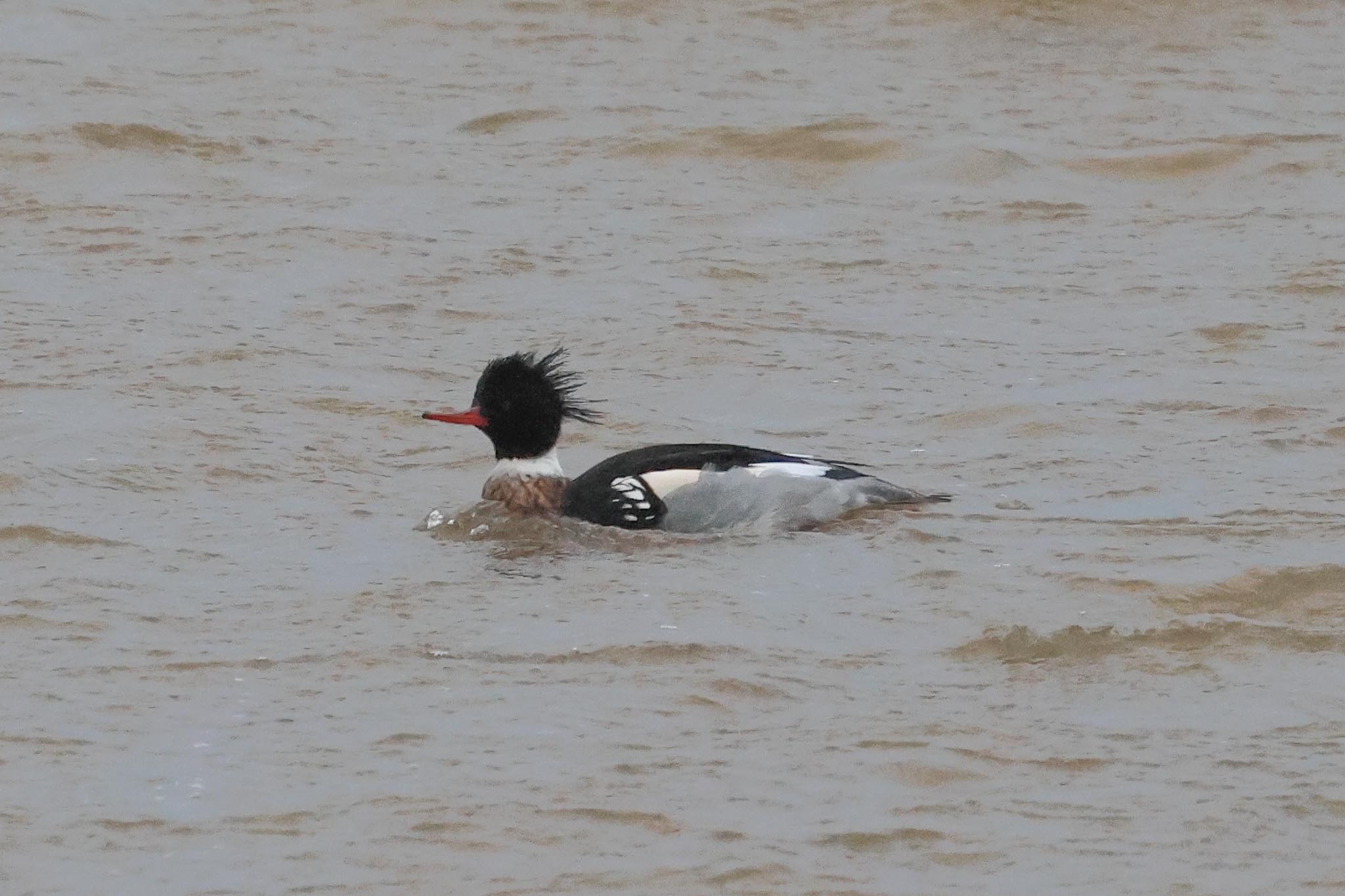
We walked back and round behind the new lifeboat station and managed to get some shelter from the wind behind the groynes. Three more Red-breasted Mergansers were in the channel much closer here, two males and a female, and the males started displaying briefly.
There were more waders opposite here, a few Knot, Ringed Plover, more Bar-tailed Godwits. A Greenshank was in the mouth of the small channel opposite before it disappeared round behind the sand. Further up, lots of Oystercatchers were roosting on the sandbar, with a big group of Knot in a tight flock in amongst them. A group of Shelducks were sleeping on the sand too.
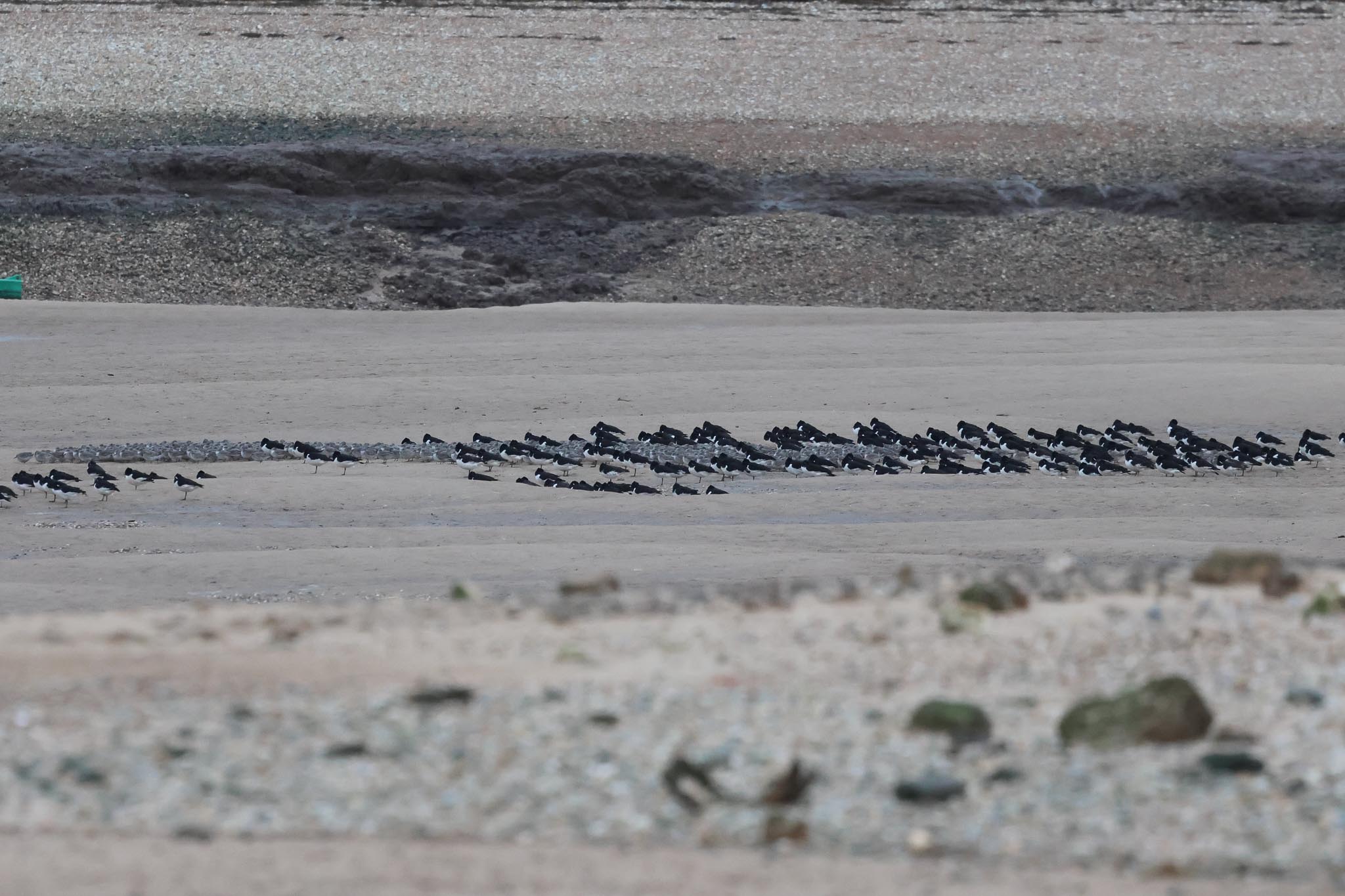
We got a message now to say that the Red-breasted Goose was already in the fields where we had looked for it yesterday afternoon, so we walked straight back to the minibus and drove over. Before we got there, apparently the farmer had already been out and flushed all the Brent Geese. Most had flown off, but there were still a few hundred there, though unfortunately they were super nervous now and took off again as soon as we drove up, landing out of view behind a hedge.
We drove round to the next road over and looked back. We couldn’t see the field where the flock was at first, but there were lots of Lapwings in the field in front of us and several Fieldfares feeding in with lots of Starlings. The Brent Geese came up again, off in the distance, and whirled round, before dropping down again out of view. We wouldn’t be able to see them from this side.
We made our way back round to where we had started, and the Brent flock was back in a field visible from the road now. They were more distant from the road but once again they took off as soon as we slowed to pull up. It felt like it might be another frustrating wild goose chase, but thankfully this time they landed again still in view just a little further back, far enough that we could even get out of the minibus to look through with the scopes.
The Red-breasted Goose was in the flock with the Brents but it was very hard to see at first, as it sat down in the middle of the group. Before we even had a proper chance to look the farmer was back on his ATV to flush the geese, presumably attracted by our presence. Kindly he at least allowed us a couple of minutes before he drove, and all at least had a quick look at the Red-breasted Goose before the Brent flock took off of their own accord and flew off over the road further up.
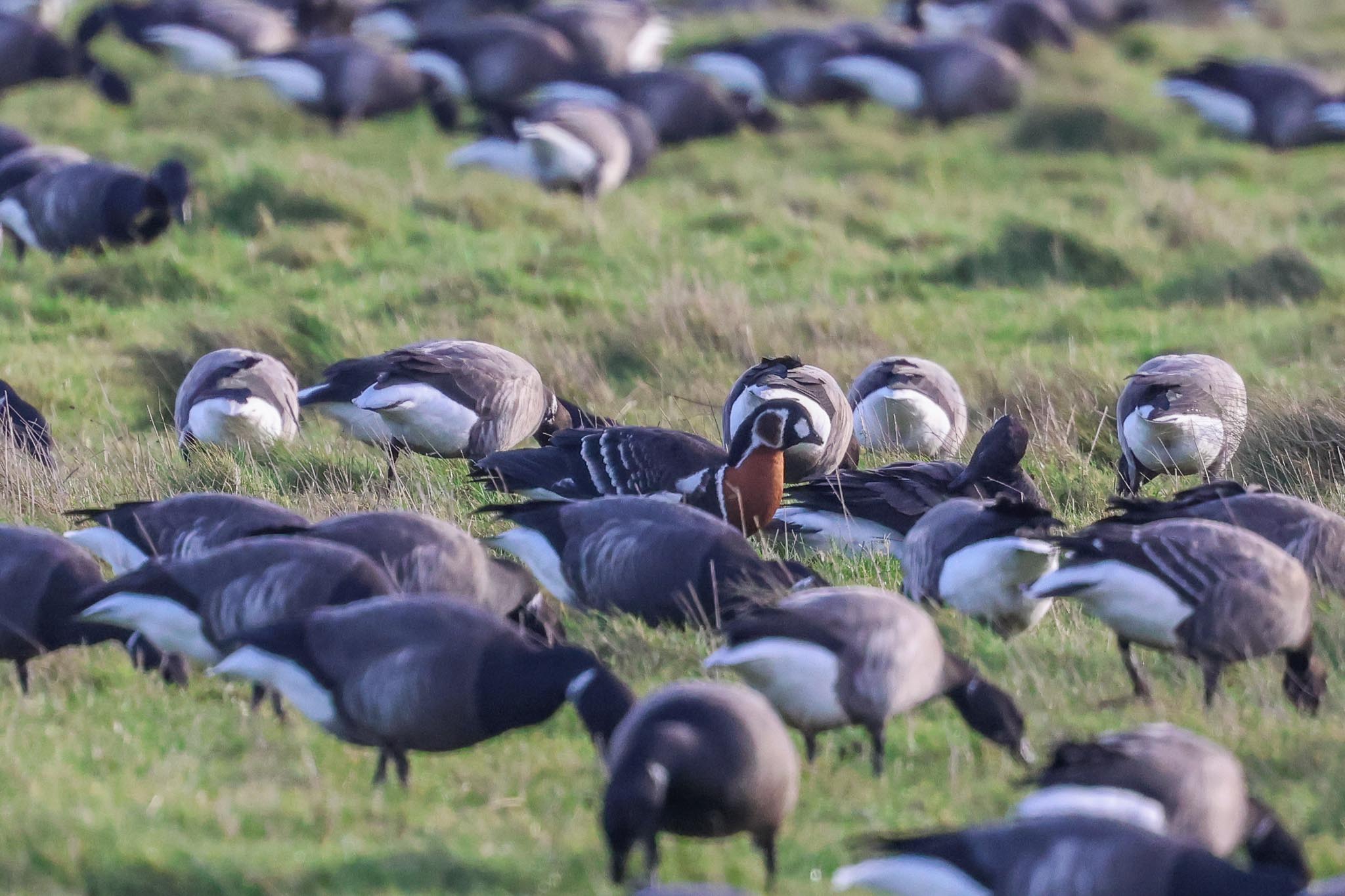
A good start, but we wanted to see if we could get better views. The farmer rode off and we continued on down the road to see if we could find where the Brents had landed. They were a couple of fields over, behind a hedge, and pretty much out of view. But we noticed a gap in the hedge, found somewhere to pull off the road, and set up the scope. Remarkably, there was the Red-breasted Goose in the gap! We had a better view of it now, for a minute or so, before all the geese moved further back in the field out of view again.
There were some light wintry flurries and it was very cold in the wind, so we got in the minibus and made our way back down to the coast. We stopped at Holkham – the Shorelarks had been reported again this morning, so we thought we would look for those, and we particularly wanted to look for Velvet Scoters too. When we got out to the saltmarsh, people walking back told us the Shorelarks had been flushed by a Merlin and flown off high west. We scanned the beach around the Gap, but couldn’t see anything out there, so continued on out to the dunes.
We managed to find a spot out of the wind and quickly located the Common Scoters. They were quite close in, several thousand of them, but the sea was rough, so it was tricky to pick out anything in with them on the water. Thankfully, they had split into several groups and birds were flying between the flocks. The Velvet Scoters were easy to see in flight, with the bright white flash in their wings, and we eventually counted at least 15 of them before the scoters all settled down again.
On our way back, we had a quick look out on the saltmarsh west of the Gap, but there were no birds there at all, so we cut back in through the pines to the Lookout for lunch. After lunch, as we drove back up Lady Anne’s Drive, we could see lots of waders feeding on the flooded fields, so we got out for a closer look. We could see a good number of Ruff and Black-tailed Godwits, Redshanks, and a couple of Dunlin too.
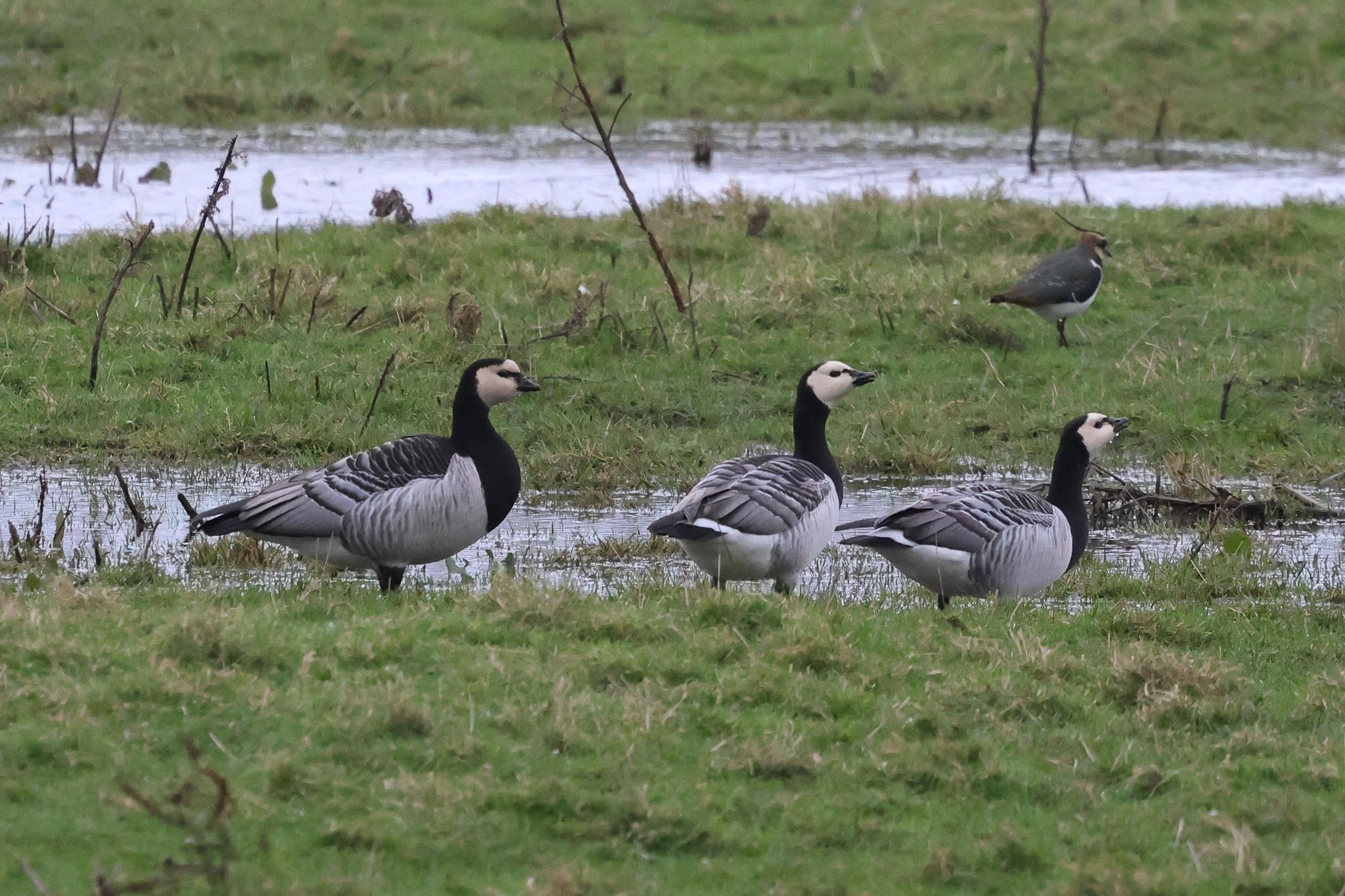
Back out on the main road, we stopped to look at the geese in their usual field. There was a big flock of Barnacle Geese in here today, at least a couple of hundred, which seem to be the feral Holkham breeders which have returned early this year. There were at least 50 White-fronted Geese too, mostly over the back of the field but a small group were much closer. A couple of Pink-footed Geese and the usual Greylags made for a very good goose selection! We made our way on west, with a quick stop to look at four Grey Partridges in a field by the road, and on to Titchwell.
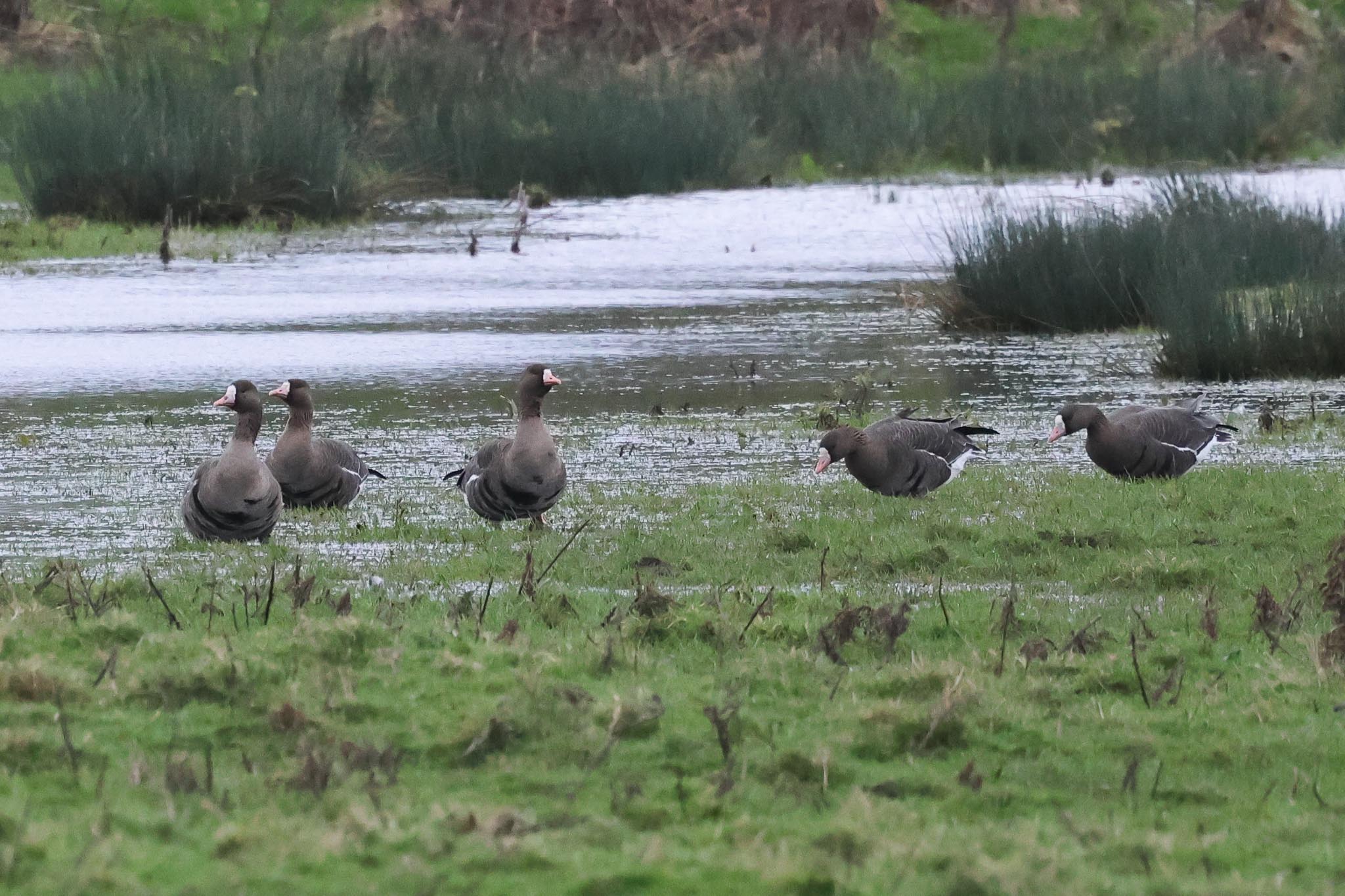
The car park at Titchwell was remarkably quiet. Once we got out of the trees on the main path, we could see why – the bitter wind was gusting 36-37mph in off the sea and across the open marshes. We couldn’t see any Water Pipits on the reedbed pool, just a few Pied Wagtails, but it was just too cold to linger long here this afternoon. The Freshmarsh was pretty much empty, as birds had presumably sought shelter elsewhere. We continued on to check the Tidal Pool and were rewarded with another Greenshank. There were lots of ducks roosting on here, but no sign of any Pintail. It was hard to keep the scopes still, so we decided to head back to shelter.
The light was already starting to go. We had a quick look at Thornham Harbour, hoping we might pick up something coming through, heading to Titchwell to roost, from the shelter of the minibus but it was too blustery. Time to head for home. We had one last surprise – as we drove back inland, what looked like a piece of white rubbish blowing across the road ahead of us turned out to be a Stoat in full ermine as we got closer and we could see it in the base of the hedge next to the road.
Tuesday 9th January
We had a particular request to try to see a Long-eared Owl, so we headed over to the Fens this morning. It was a lovely sunny morning for the long drive with wall to wall blue skies, and just a light frost. When we arrived and disembarked, it was nice to find that the wind was a lot lighter inland too. As we walked in along the track, a Fieldfare flew up from the verge and landed in the hedge beside us. A Green Woodpecker laughed behind us and landed in the top of a dead tree.
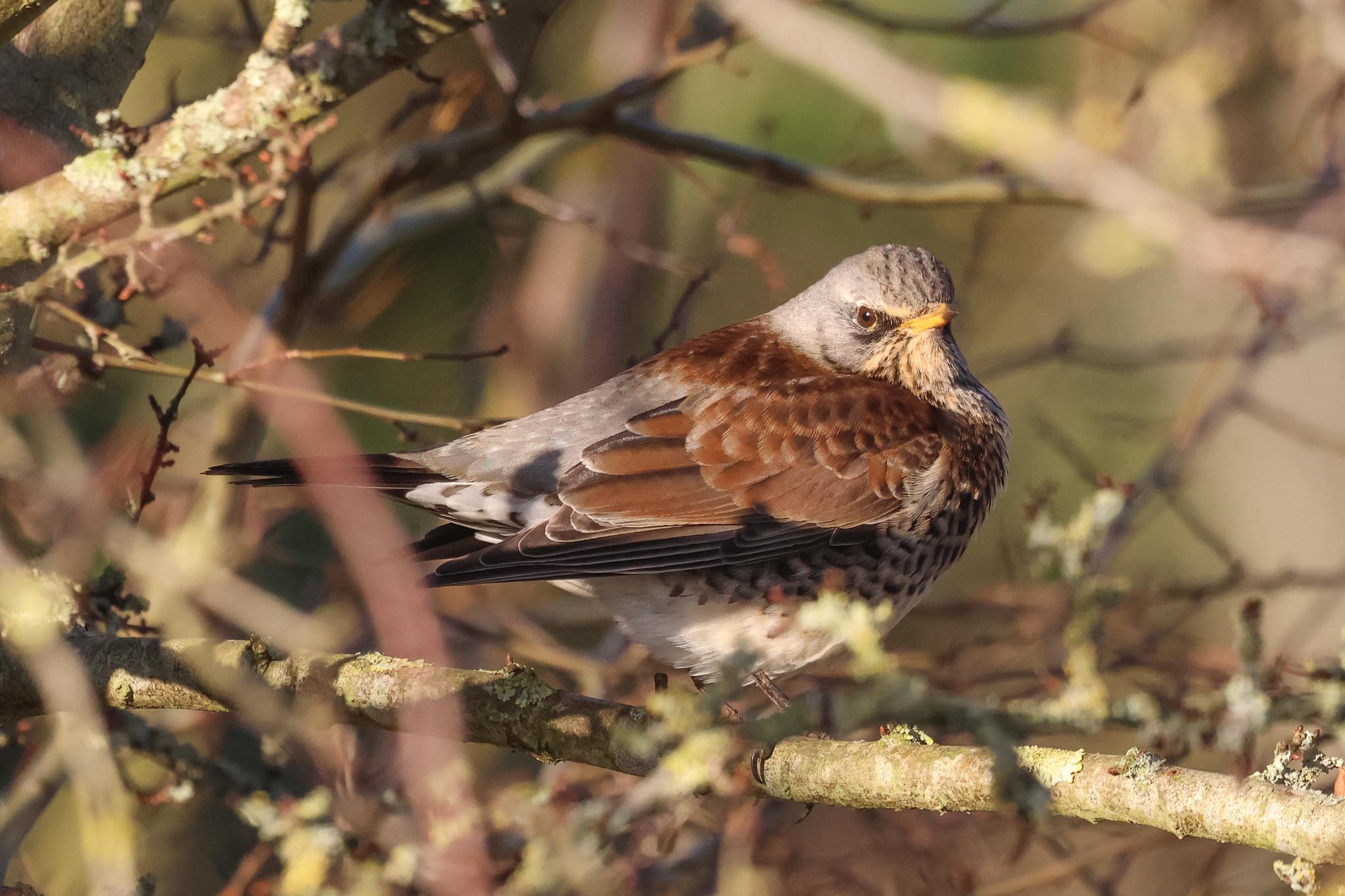
We walked down to the hide and opened the flaps. A quick scan revealed a Long-eared Owl tucked in the ivy, very close to the hide. We could see two eyes staring back at us, until it went back to sleep, and most of one of its ear tufts, between the leaves. There was probably a second Long-eared Owl deep in the ivy too.
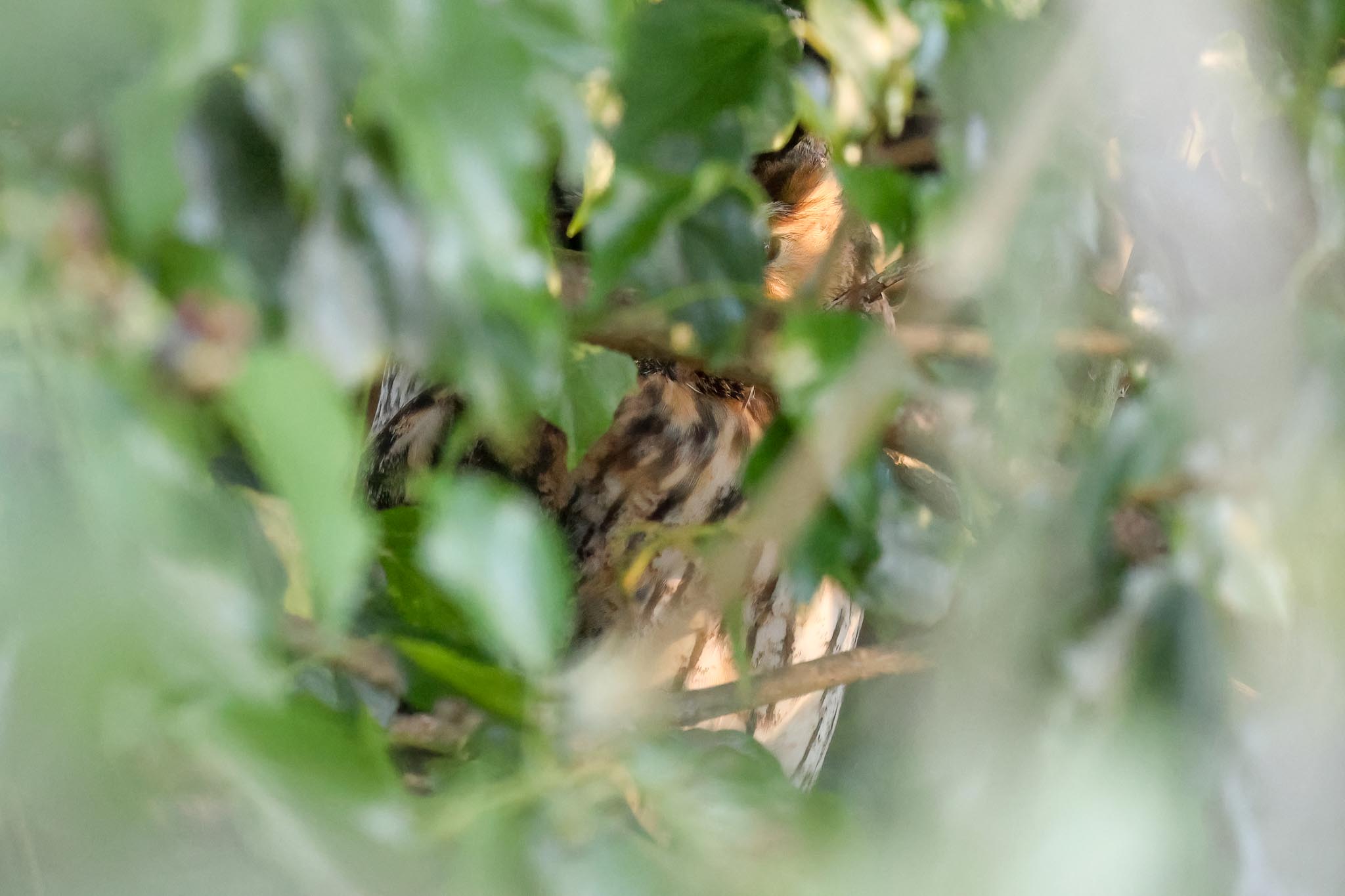
There were not so many ducks as normal on the main lake, only a few distant Goldeneye and no sign of any Goosander, as well as the regular Gadwall, Wigeon, Teal and Tufted Duck. There were a couple of distant Common Pochard too.
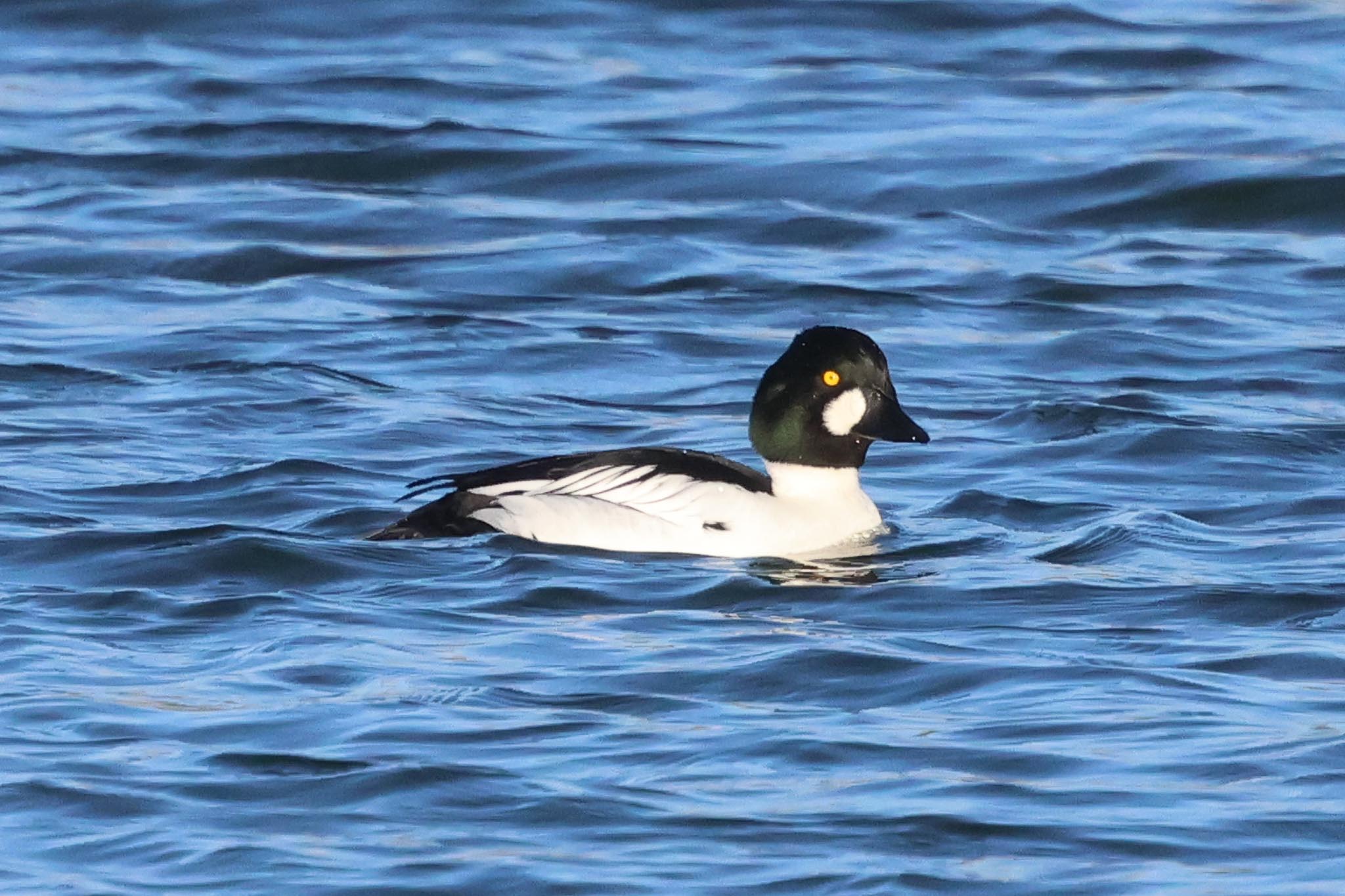
There has been a Glossy Ibis on site for the last week or so, so we went on to look for that now. Out on the riverbank, the pools it had apparently been on were frozen over, so we walked downstream to look at the west pit. The wet grass around the edges of that were frozen too, and there was a work party out there over the far side, cutting trees and having bonfires, so probably no chance of it feeding on there today. We walked back up and another birder appeared who pointed out that that the Glossy Ibis was along the side of the river further upstream. You had to stand in just the right spot to see it between the trees, but we got it in the scopes now and had a good view.
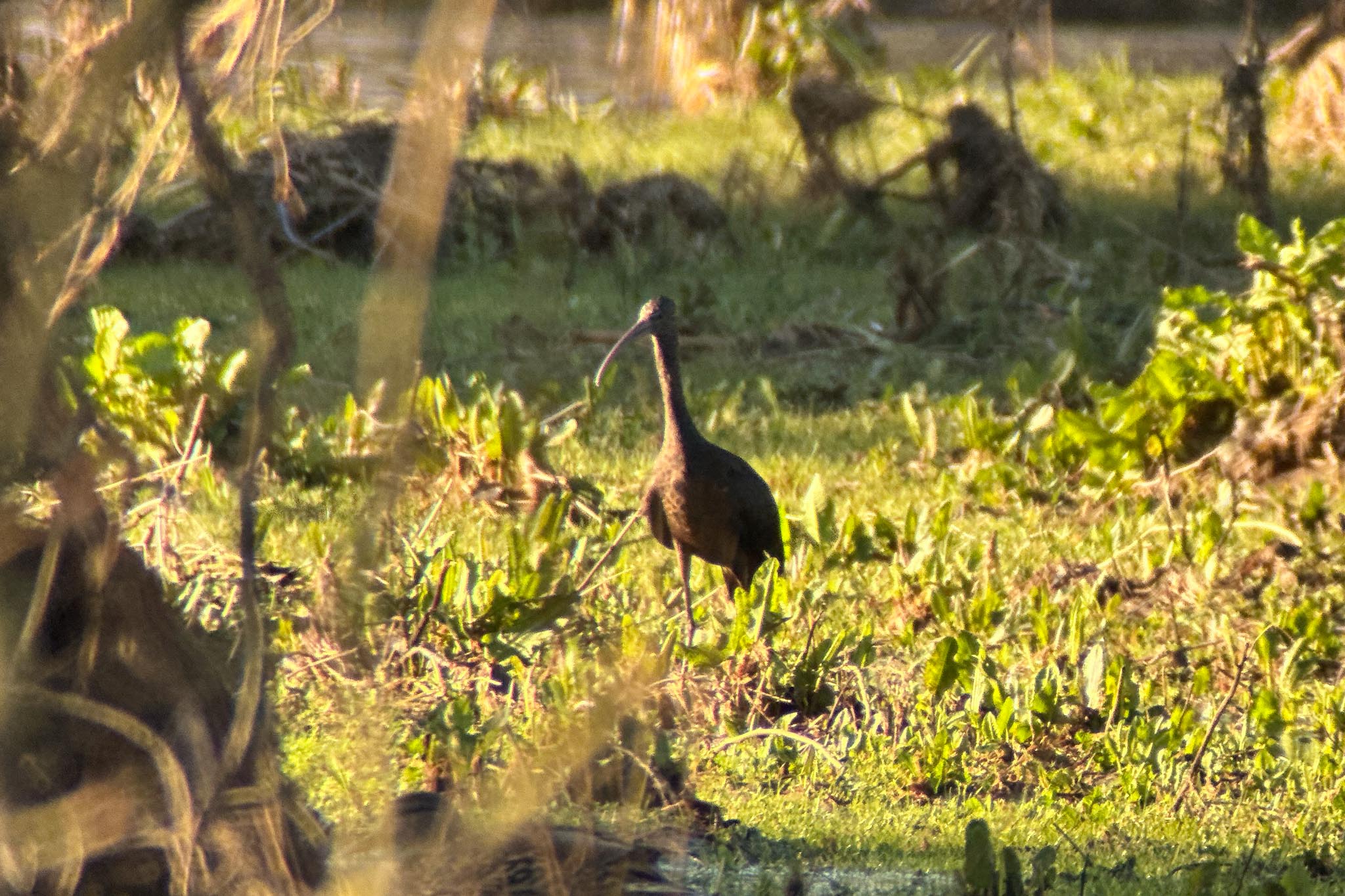
We made our way back to round to the hide, and the Long-eared Owl we had seen earlier had shrunk back into the leaves. We could see another one more clearly now, but where it had chosen to perch, we could see its bottom half but its head was completely hidden.
We had options to spend the rest of the day exploring the Fens, but with nothing on the particular target list elsewhere here, the decision was made to head back in to Norfolk. As we were passing, we stopped briefly on the King’s Lynn bypass to check the Hardwick flood lagoon. There has been a Black-throated Diver on here for a couple of weeks, but we couldn’t find it now. It may have been out of view in one of the bays or behind the reeds. It had been much calmer inland but we were back in the blustery wind now, and it was time for lunch, so we decided not to hang around.
We only had a couple of hours left this afternoon, so we made our way up to Titchwell again, to see if we could find some of the birds we had missed in the weather yesterday. After a quick lunch in the picnic area, we headed out onto the reserve. It was very windy out on the main path beyond the trees again, if anything worse than yesterday, though at least it was still bright and sunny today. There was no sign of the Water Pipit again and the Freshmarsh was empty – probably a combination of the wind and diggers working on the marsh at the moment, currently fixing the east bank sluice.
We continued on out past the Volunteer Marsh. Four Pintail flew in past us, circled over the Freshmarsh behind us, and then headed back out towards the beach, a nice addition to the trip list. Out at the Tidal Pool, there were lots of birds but it was next to impossible to keep the scope stable enough in the wind. The birds were all facing away from us too, into the wind. There were more Grey Plover sheltering on here today, and more Common Redshanks, but we still couldn’t find any sign of the Spotted Redshank. We had a quick look at the sea from the lee of the dunes, which was cutting up quite rough. The Sanderling were still running up and down along the shore.
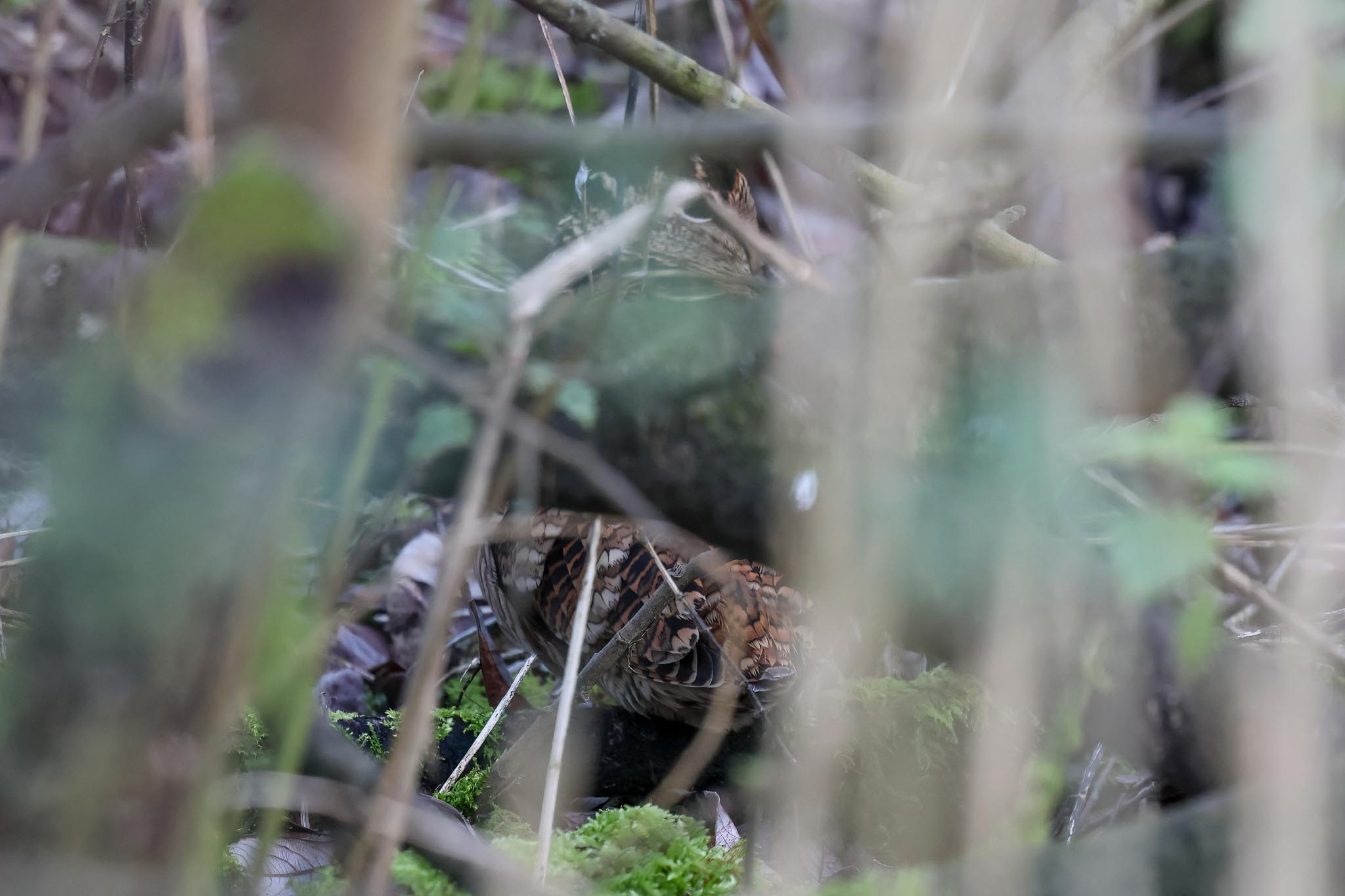
We headed back to the shelter of the sallows and cut in along Meadow Trail. There have been some good counts of Woodcock coming in to roost very early in the mornings here in recent days, so we thought we might be able to find one roosting under the trees. The first bird we found was a Water Rail feeding on the edge of a small pool deep under the trees. Then a little further on, we found a Woodcock too. Success! It was tucked in amongst the branches, but by moving around we could get a good view of most of it, We spent some time watching that, before it moved deeper in. Then a little further on, we quickly found a second Woodcock too, feeding close to the path. It was a little too close though and quickly disappeared back in between the branches.
A member of staff walking past told us that the Water Rail was back in the ditch by the main path, so we walked round to see that. Good views even if the light was now starting to go. A very successful couple of hours here, and the sun was setting now as we walked back to the car park.
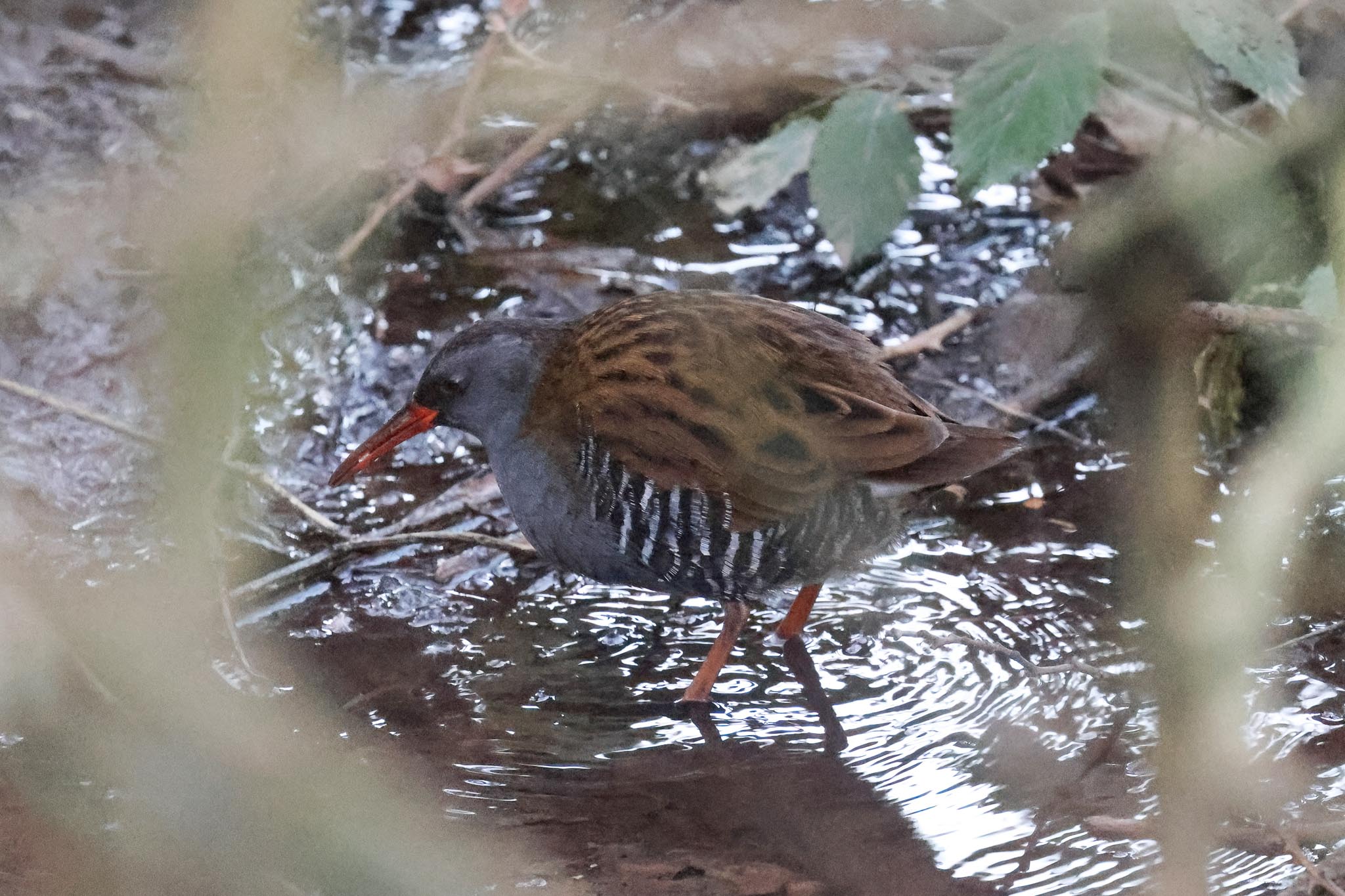
Wednesday 10th January
On our way down to the coast, we drove round via Wiveton. A lone Cattle Egret was still in one of the flooded fields by the road, despite the absence of any livestock. We wanted to look for the Velvet Scoters along the coast east of Cley this morning, as they have been close in at times. The wind was meant to drop today, which would make viewing ducks on the sea easier, but it hadn’t gone down as much as forecast and it was still rather blustery when we got out of the minibus.
We had a quick look at Salthouse first, as the scoter flock had been down this end yesterday afternoon. We couldn’t see any off the beach here – a young Grey Seal was hauled out near the top of the shingle and looked up at us as we came over the crest. A flock of 11 Red-throated Divers flew past out to sea, catching the early morning light.
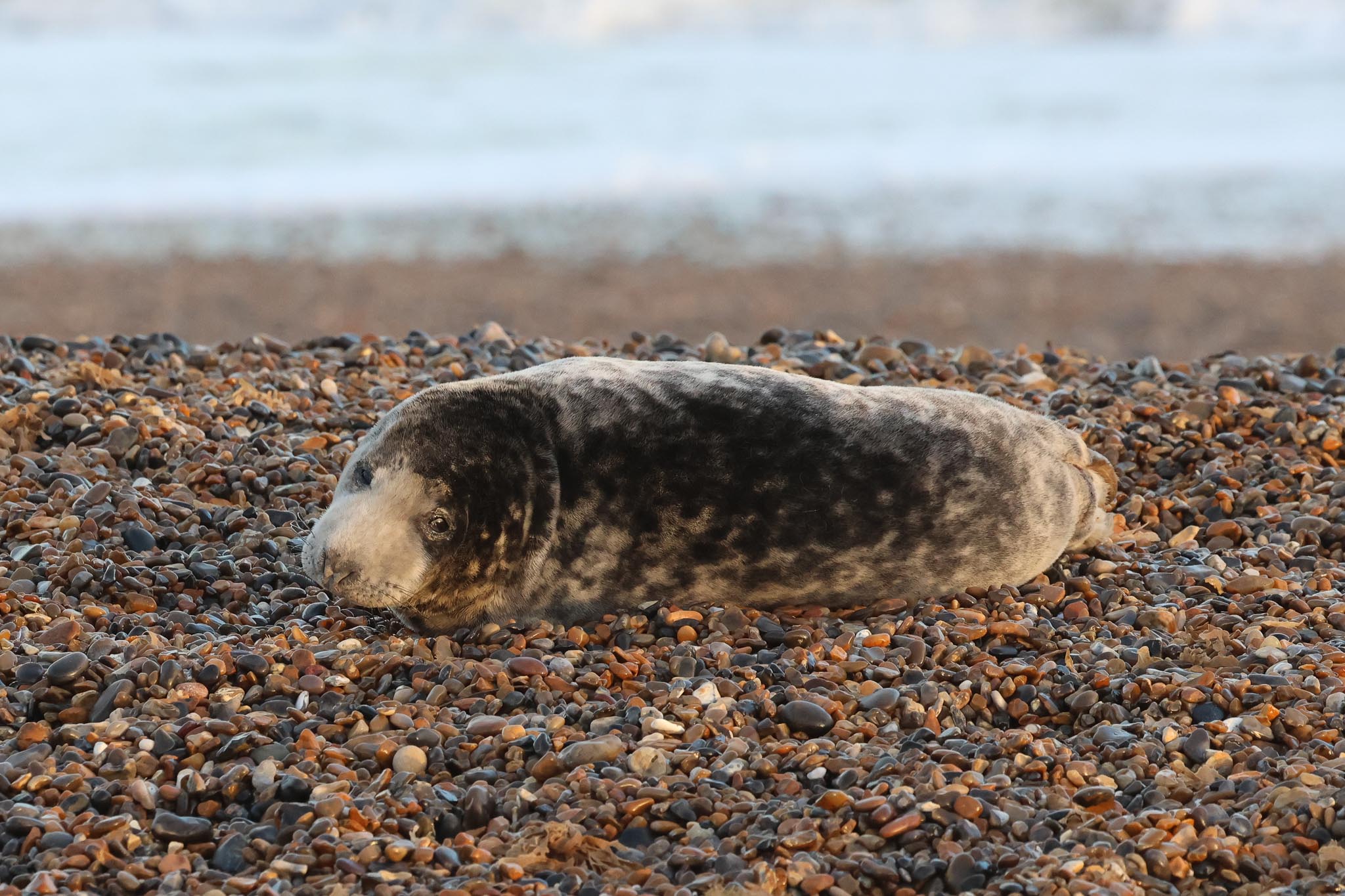
The scoter are more regularly off Kelling, so we headed round there next. As we parked in the village, a Grey Wagtail flew up out of the beck. The top part of the lane was quiet – the verges have been mown to within an inch of their lives, all the seedy vegetation is gone along the beck, and the hedges shredded back again. Presumably so it looks ‘tidy’! As we got down to the crosstrack, two Grey Partridges flew out of the field ahead of us, landing briefly on the path before flying off again. There were lots of Rooks feeding out on the Quags, which looked particularly smart in the low winter sunshine.
There was a nice selection of ducks on the Water Meadow pool. As the high water levels of recent days are receding, there is some nice wet grass appearing round the edges. As we looked over the hedge in the far corner, a Common Snipe came up from the vegetation. Just beyond, a couple of Brown Hares had taken shelter from the wind behind a small bramble clump and were warming themselves in the morning sun.
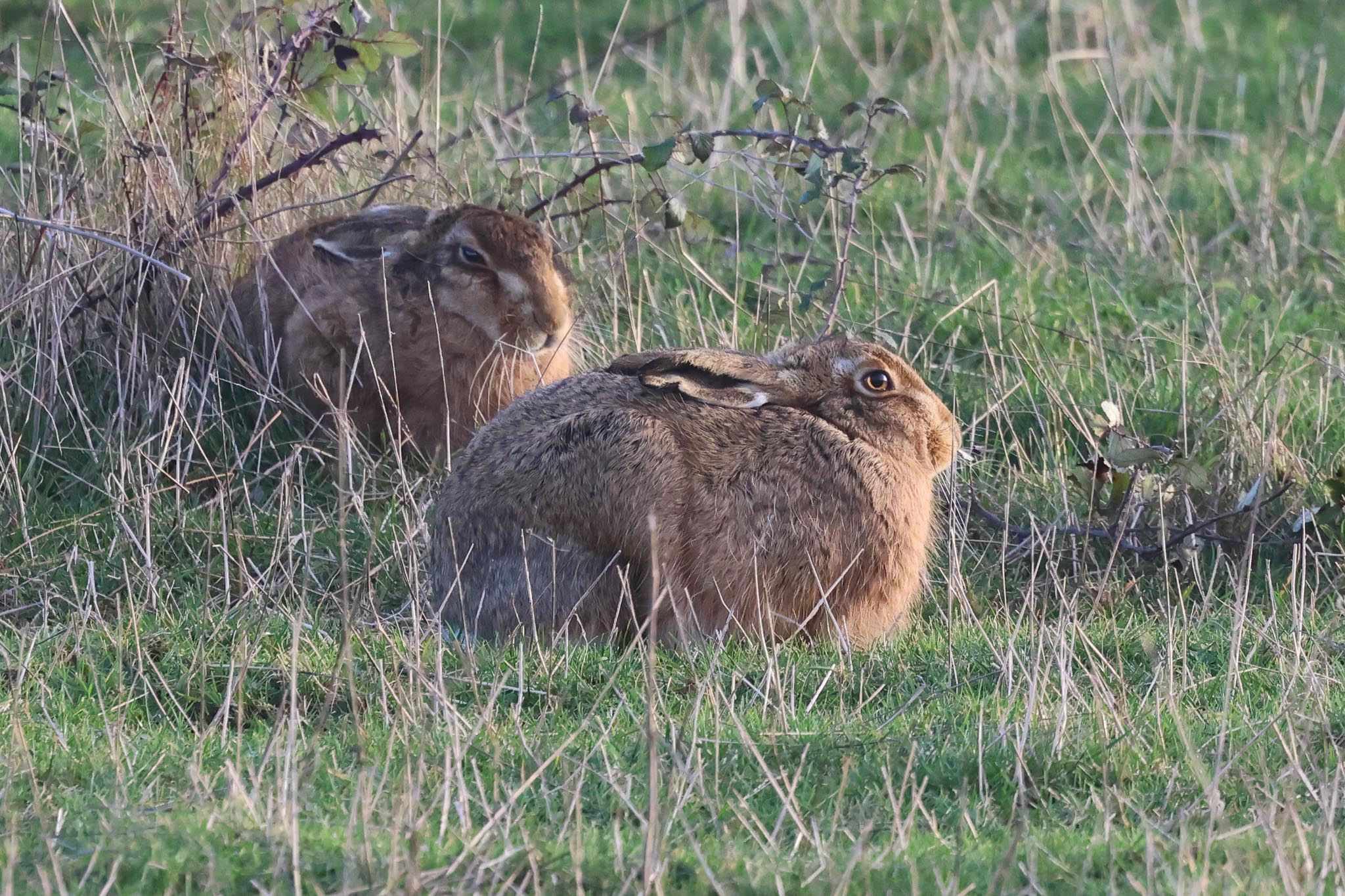
As we climbed up to the top of the shingle, there was a large raft of Common Scoter quite close inshore, but they were very nervous and flew before we could down from the skyline the other side. There was no sign of any Velvet Scoters in with them, and they landed further east with another larger raft. We scanned through them, several hundred strong, but they were mostly facing into the wind, so away from us, and diving continually. We picked up a smaller group just to the west of us, which was easier to look through and found a smart drake Eider in with them. We had some really nice views of the Common Scoters now too.
The scoter started to drift back inshore and gather in front of us, but were flushed again by two people walking along the shoreline and went off east again. We waited and scanned, and gradually they returned once more. We could see them much better now and finally we started to find the Velvet Scoters in with the Commons, at least three of them though it was hard to keep track. Lovely views new, quite close in, with the Eider alongside them at one point too.
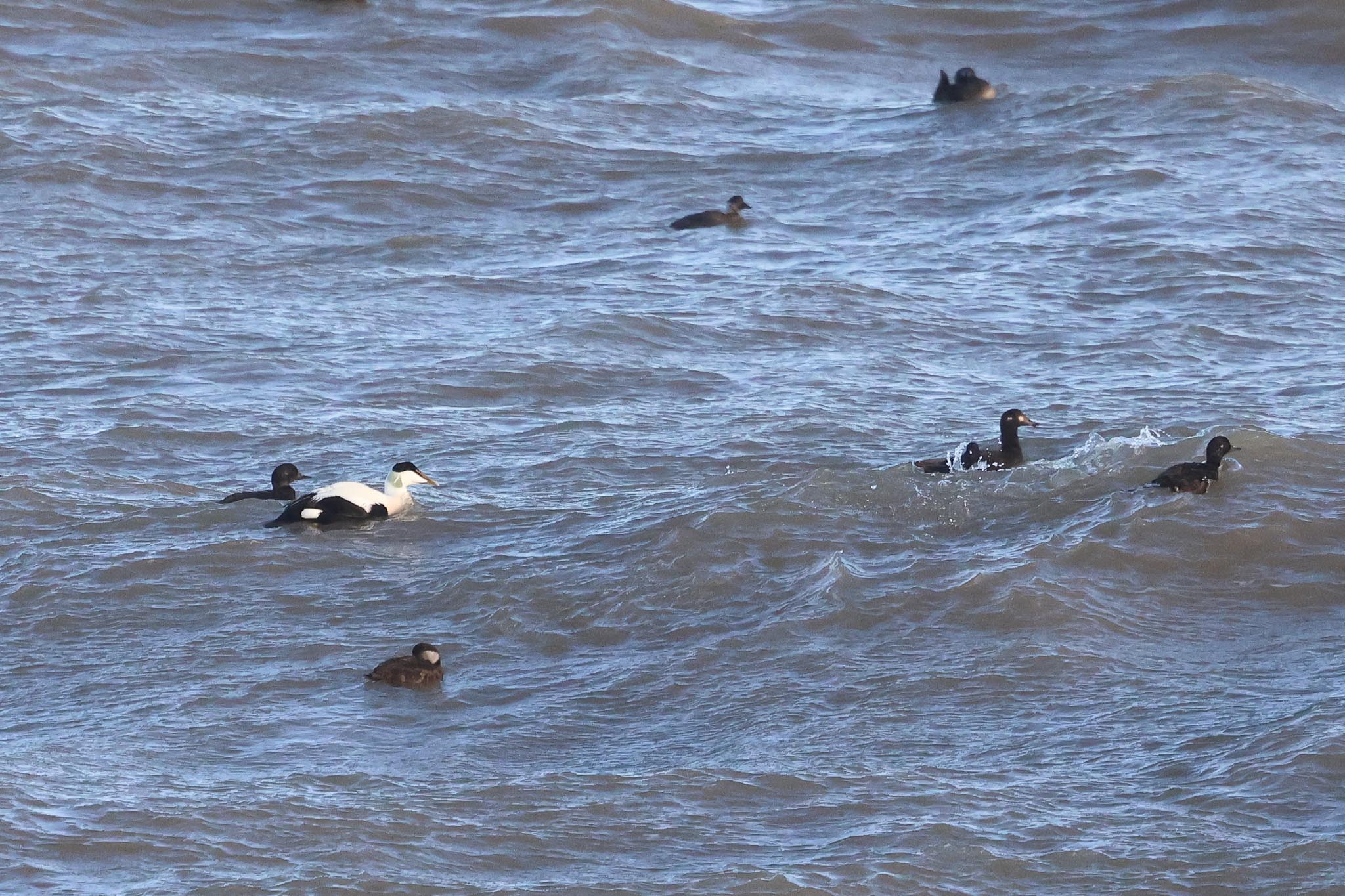
It was cold out on the beach, so we decided to head back and warm up. A Water Rail scuttled across between clumps of rushes as we passed the pool. We had a couple of options now – we could go back to Holkham to have another go for the Shorelarks, or we could head out to Stiffkey Fen to see if we could relocate a Glaucous Gull which had been seen earlier, distantly out on Blakeney Point. We knew the latter would be a long shot, but the preference was to have a walk out there.
As we got up onto the seawall, a Greenshank was on the mud in the channel in front of us, along with several Redshanks and a tight flock of Dunlin which flew up and whirled round. The water level on the Fen is very high, so we made our way straight round to the corner of the coastal path overlooking the harbour and found a sheltered spot out of the wind.
There were lots of gulls out in the harbour, but no sign of the Glaucous Gull. We could see several groups of Great Black-backed Gulls out on the sands beyond, feeding on a number of seal carcasses, and those were just the ones we could see from here so there was plenty of food around. More gulls were roosting in larger groups on the mud closer to us. The light was really good and there was a nice selection of waders out in the harbour, plus a good number of roosting Pintail and several distant Red-breasted Mergansers out in the Pit.
It was time for lunch, so we made our way back. A Stonechat was getting chased around on the seawall by a Robin now. We decided to head round to Stiffkey Greenway where we could look out over the saltmarsh. On the way, we pulled up briefly in the village opposite the Red Lion. The Glossy Ibis was feeding out on the grass on the near edge of the flood today, so we had really good views of it as it probed its long bill into the grassy tussocks, better than the views we had yesterday.
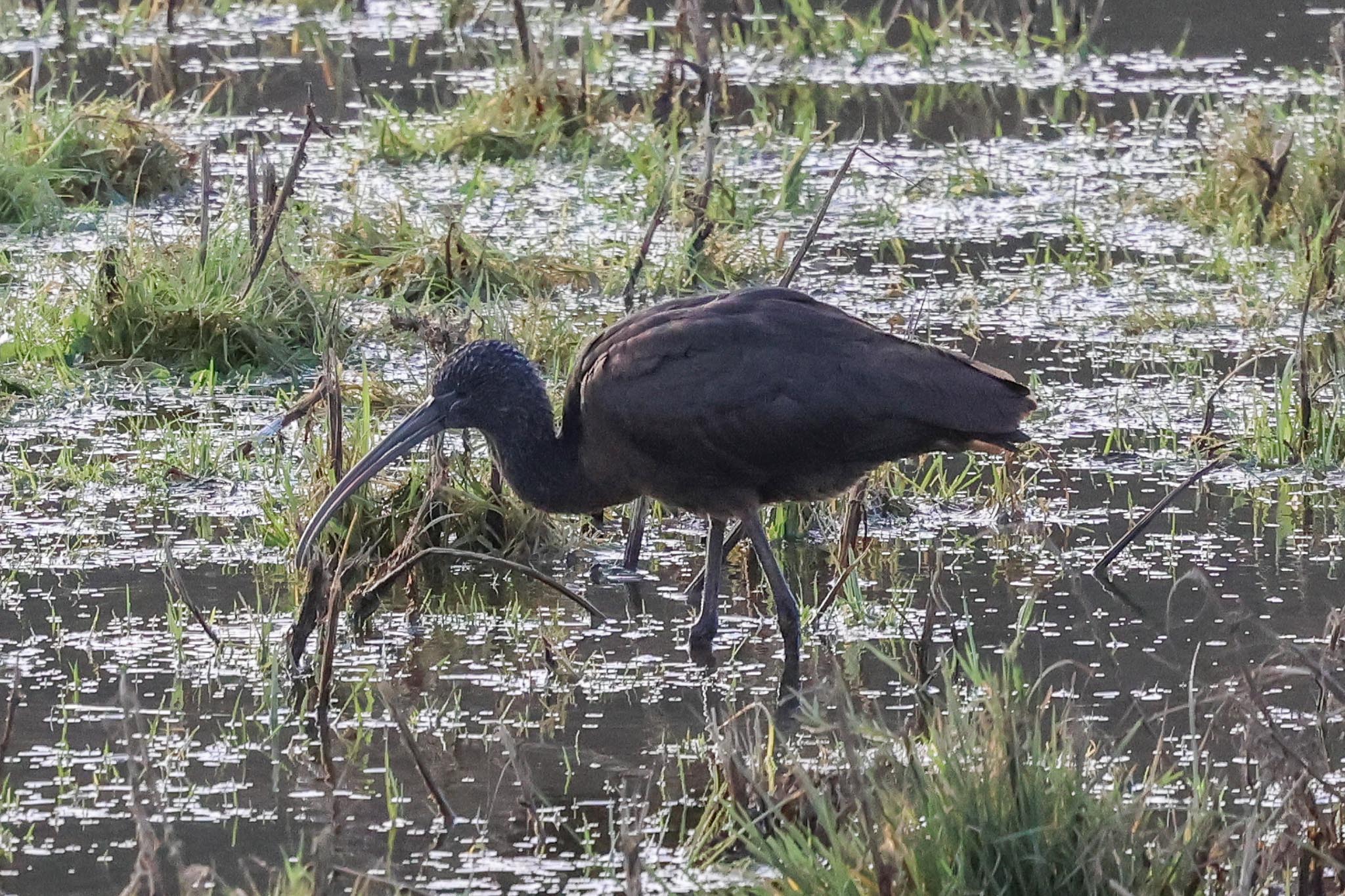
When we arrived at Greenway, a Red Kite was hanging in the air over the saltmarsh and drifted across right in front of us. We could see its was carrying a white wing tag and managed to grab a couple of photos so we could read the code. It turned out to have been ringed further east in Norfolk last June. There was a bit more raptor action while we ate – a juvenile Peregrine chased a small wader round and round high over the saltmarsh for a while, but showed its inexperience, as it kept missing it; a female Marsh Harrier flew past in front of us too.
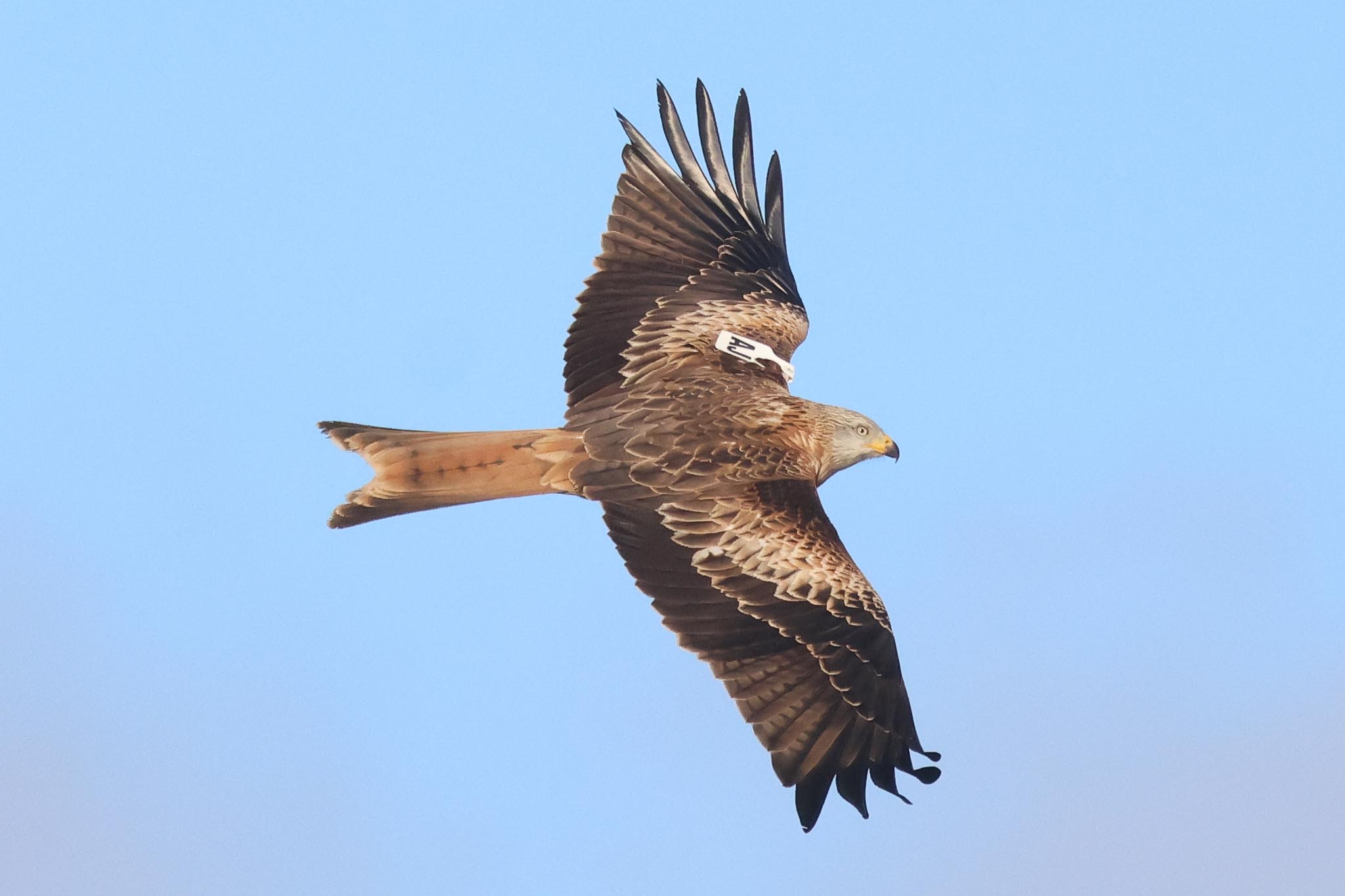
It was heading for 2pm, so given the raptor activity, we decided to go straight round to Warham Greens now to see what we could catch up with there. We had just pulled up on the concrete pad, and were looking through the birds in the nearby hedge, when we had a glimpse of a harrier over the field behind. It was a ringtail, so we leapt out and got to the field entrance where we could see it going away from us over the field – a ringtail Hen Harrier. It banked over the hedge and we lost sight of it as it went round behind the old barn. A good start!
Down at the edge of the saltmarsh, one person was already there. Apparently we had just missed a Merlin and as we scanned back and forth it was now rather quiet. There were one or two distant Marsh Harriers over the back of the saltmarsh and a Peregrine briefly over East Hills. As we got closer to 3pm, raptor activity picked up again. A few more Marsh Harriers flew in and then a smart grey male Hen Harrier drifted across and landed out on the saltmarsh. A ringtail Hen Harrier flew past over the back of the saltmarsh too.
Just after 3pm, we picked up a ringtail harrier flying out from the fields to our left. As it turned, we could see its slim wings and pointed ‘hands’, with only four visible primary tips, the Pallid Harrier! It flew across low over the saltmarsh towards us, and we could see it had a bulging crop, so it had fed well. Then it dropped down onto the saltmarsh out of view behind some bushes.
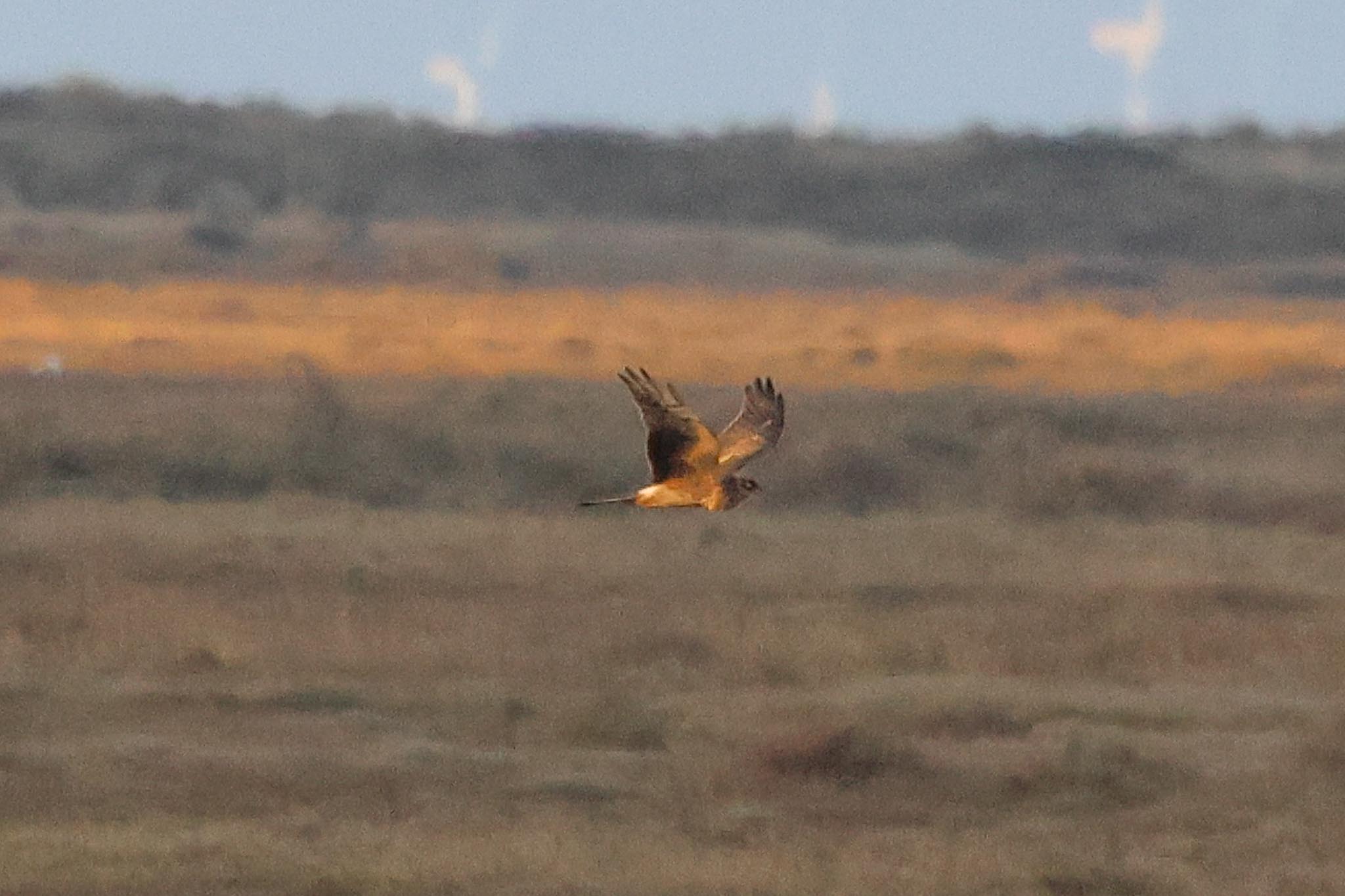
We waited a couple of minutes to see if the Pallid Harrier might come back up quickly, but it could sit there now until it was time to roost. We had already been here some time and it couldn’t be called warm, so with mission accomplished we decided to call it a day.
As we made our way back up the track, several skeins of Pink-footed Geese flew in over the fields calling. A lovely sight – and sound – against the pink-tinged clouds and a fitting way to wrap up our three days.
















